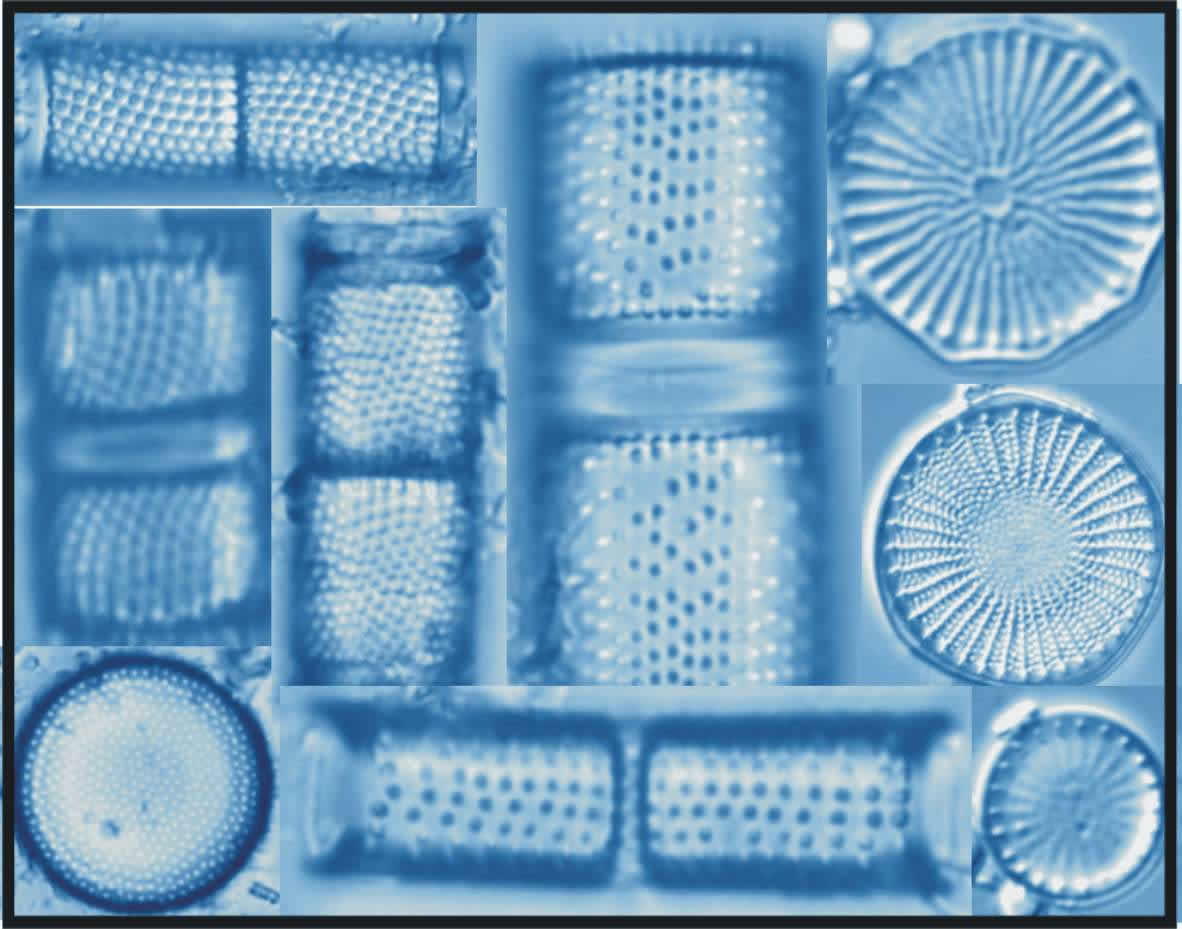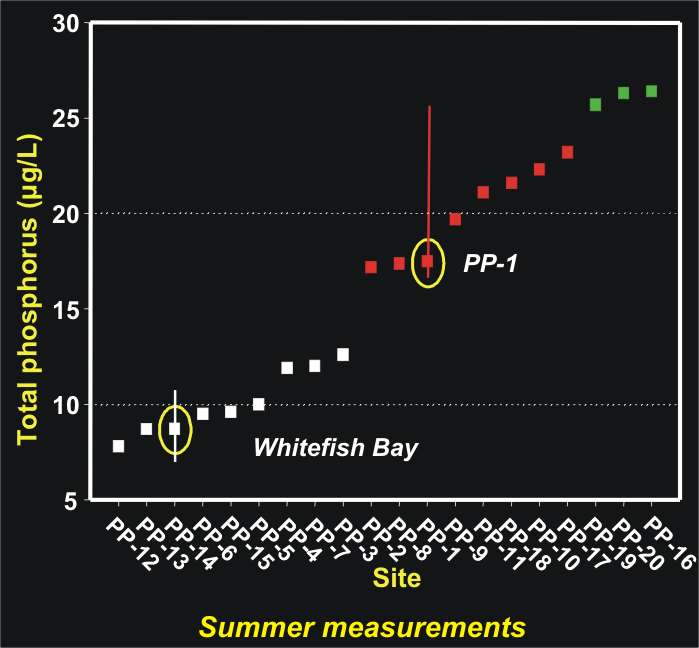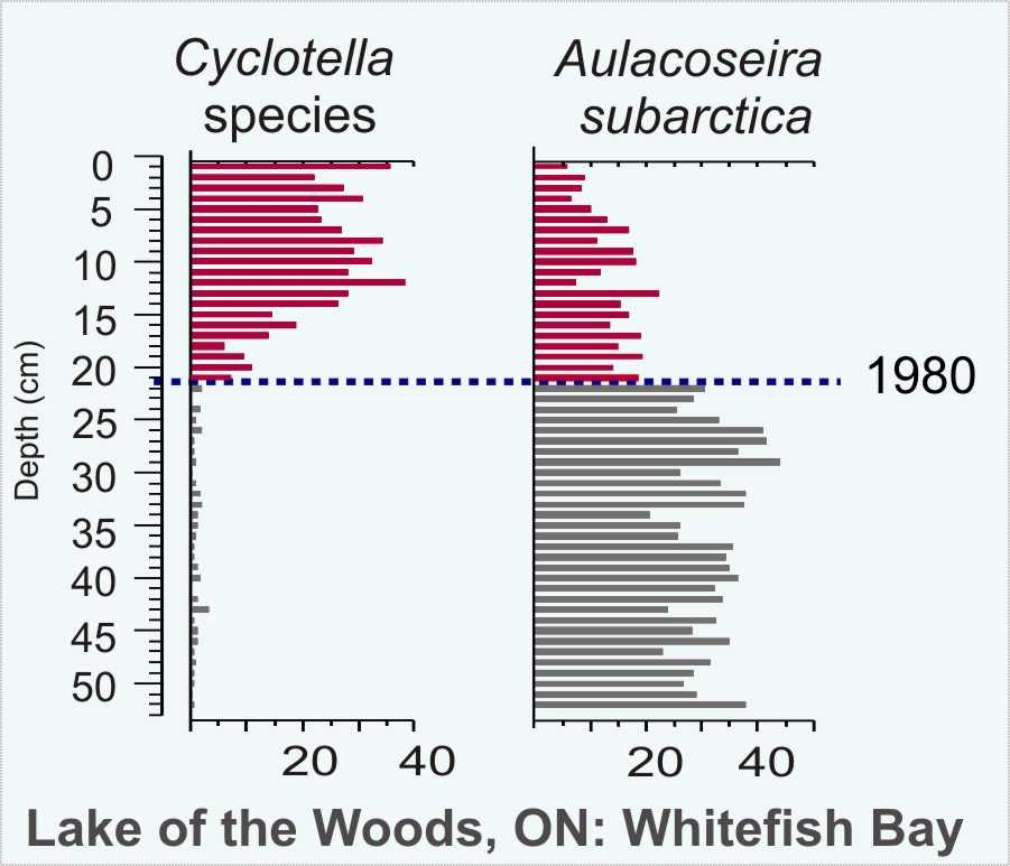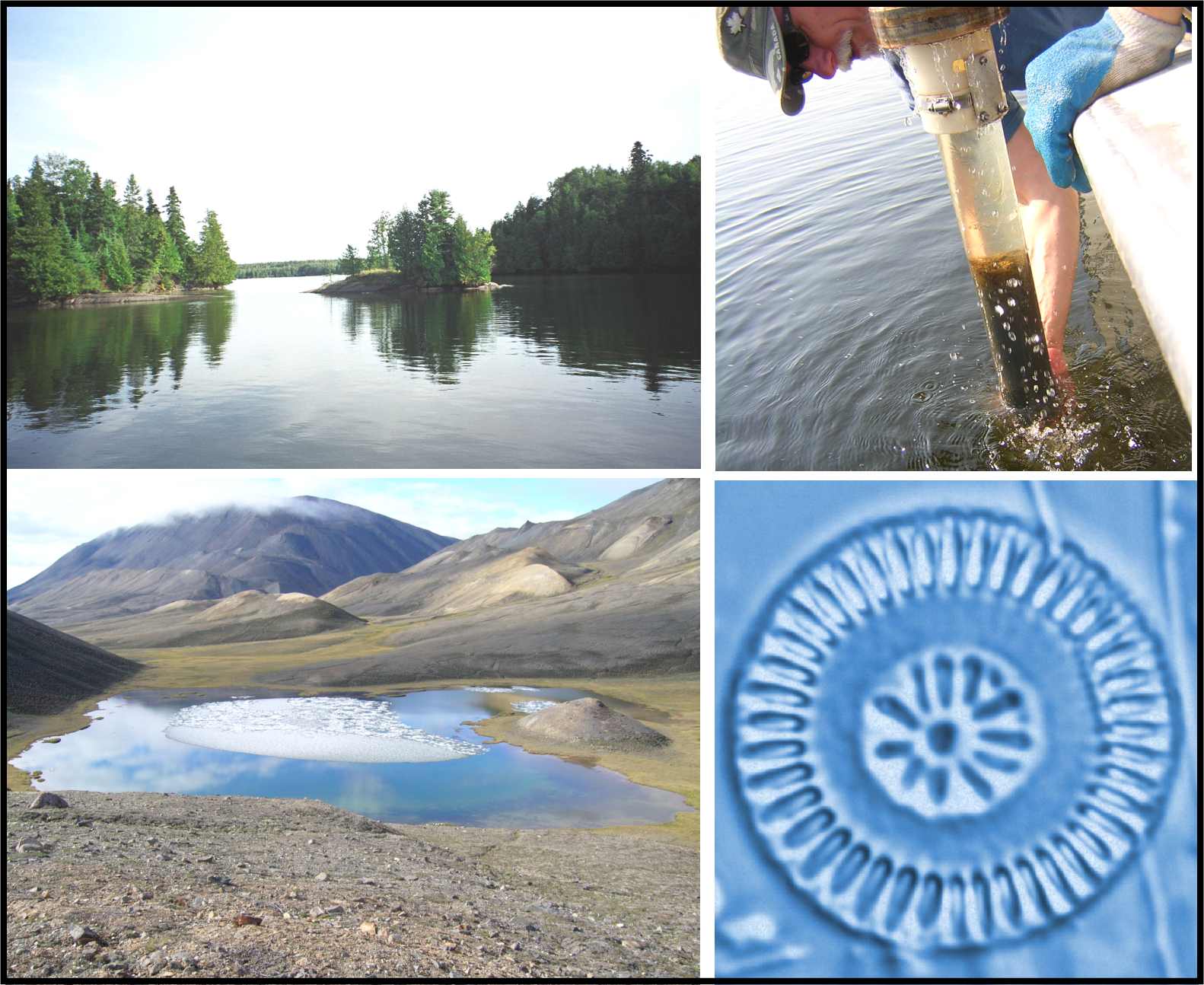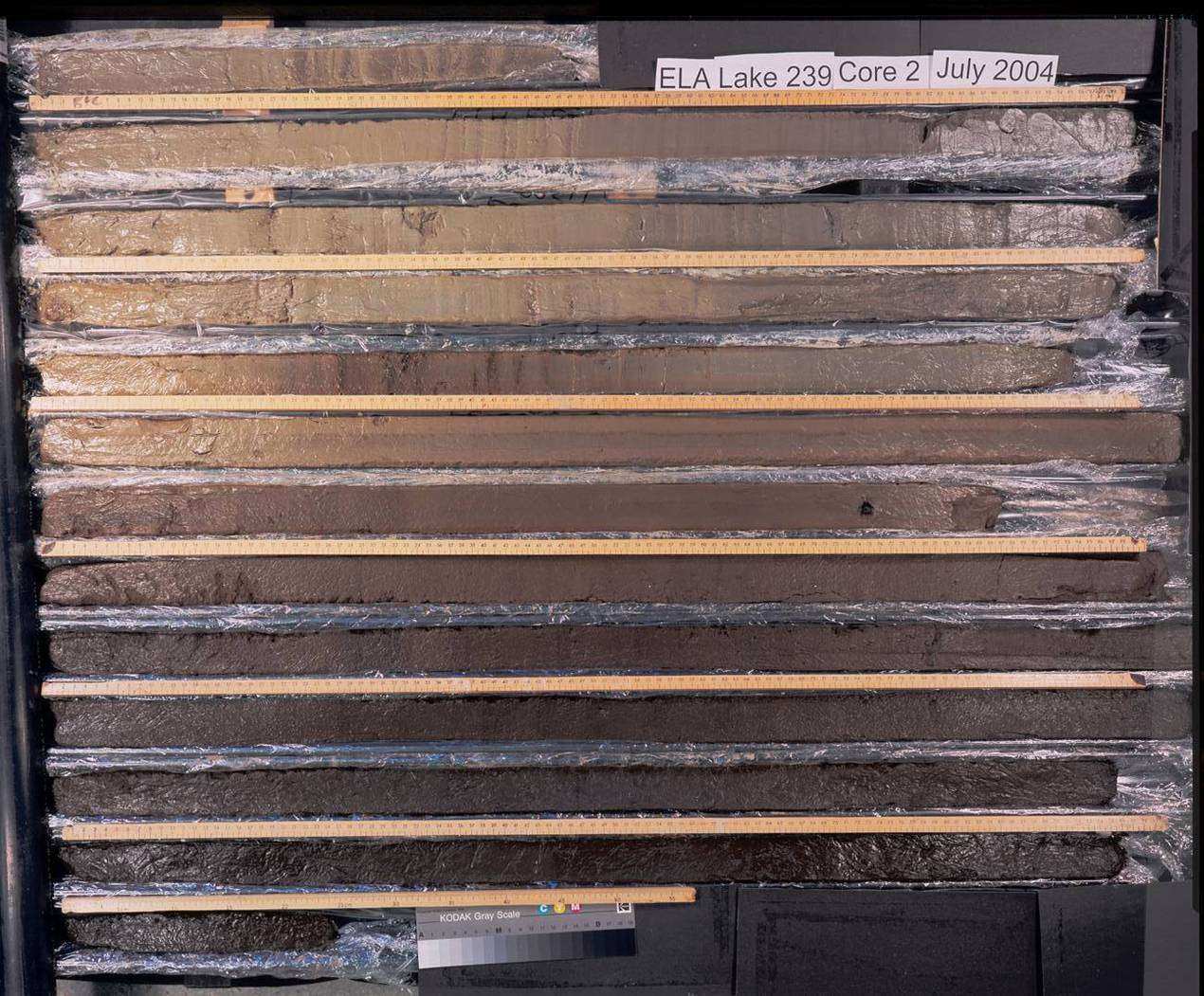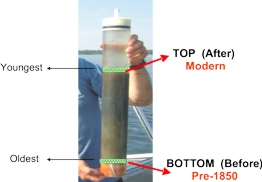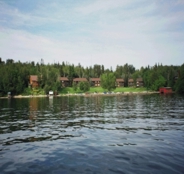
| |
| HOME |
| PEOPLE |
| RESEARCH |
| PRESENTATIONS |
| NEWS & LINKS |
| P.E.A.R.L. |
| Paleolimnological Research |
||
DIATOMS
TP GRADIENT
WATER QUALITY
DIATOMS & WARMING
HOLOCENE TRENDS
BEFORE & AFTER
Development & Water Quality
OTHER INDICATORS
|
Diatoms as environmental indicators in the Lake of the Woods (LoW) |
|
The diatom flora of the Lake of the Woods is relatively diverse reflecting the complexity of this large lake. This link will take you to the results of a diatom taxonomy workshop that brought together researchers working in the Lake of the Woods region. The pdf of this booklet contains numerous photomicrographs of diatom taxa that were commonly encountered and can be used as a guide for taxonomic identifications. |
||
| LoW phosphorus gradient: development of a diatom-based inference model |
||
Although algal blooms have been reported in the southern portion of the lake since the early 1800s (McElroy and Riggs 1943), anecdotal evidence suggests that water quality has deteriorated in the northern bays in recent years with an increase in the frequency and intensity of toxin-producing cyanobacterial blooms. However, given the lack of long-term data these trends are difficult to verify. Furthermore, data describing the relative importance of natural (e.g., geological) and anthropogenic sources of algal nutrients are scarce, and thus the relative sources of nutrients to the lake are not fully understood. As a first step, our research examined the spatial and seasonal patterns in water quality in this highly complex lake on the Canadian Shield (Pla etal. 2005). Further, we examined surface sediment diatom assemblages across multiple sites to determine if they track within-lake differences in environmental conditions. Our results show that there are significant spatial patterns in water quality in LoW. Results are published in J. Great Lakes Res. 31:253–266 S. Pla, A. M. Paterson, J. P. Smol, B.J. Clark, and R. Ingram.
|
||
| Historical trends in water quality: paleolimnological study | ||
There has been much interest in determining whether there have been historical changes in total phosphorus (TP) concentrations throughout the LoW and whether the purported increase in the frequency and intensity of cyanobacterial algal blooms in the northern basin can be linked to recent increases in TP concentrations. Dated sediment cores retrieved from four sites in the north end of the lake (Whitefish Bay: reference; PP-1: impacted; Bigstone Bay: impacted; Forrest Island: impacted) were analyzed for changes in the relative abundances of diatoms to determine whether TP concentrations have changed substantially over the last ca. century. An emerging trend from this study is that dramatic changes in the diatom assemblages over the past few decades is consistent with recent climatic warming and coeval with the two warmest decades on record (1980s and 1990s). More coming soon [click to see posters - Bigstone Bay & Forrest Island] [click here to see slide show]
|
||
| Planktonic diatom responses to recent warming | ||
In this study we found significant increases in the relative abundances of small planktonic Cyclotella taxa concurrent with sharp declines in both heavily silicified Aulacoseira taxa and benthic Fragilaria taxa in over 200 paleolimnological records from nonacidified/nonenriched lakes throughout the Northern Hemisphere. These species-specific diatom shifts occurred in conjunction with changes in freshwater habitat structure and quality, which in turn, we link to hemispheric warming trends. In our detailed paleolimnological case study, we report strong relationships between sedimentary diatom data from Whitefish Bay, Lake of the Woods, Ontario, and long-term changes in air temperature and ice-out records. These data provide strong evidence that unparalleled warming over the last few decades resulted in substantial increases in the length of the ice-free period, that similar to 19th century changes in high-latitude lakes, likely triggered a reorganization of diatom community composition. We show that many nonacidified, nutrient-poor, freshwater ecosystems throughout the Northern Hemisphere have crossed important climatically-induced ecological thresholds
|
||
| Long-term environmental changes in the LoW over the Holocene | ||
Data on long-term water quality changes in the Lake of the Woods (LOW), an important water body with multiple and diverse users, are necessary to place the present (and future) environmental state of this important and complex freshwater system into a larger temporal context and to establish baseline conditions (for any future mitigation). Long-term changes over the Holocene (e.g. ~last 10,000 years) in diatom assemblages and other biological indicators from different trophic levels (ostracodes, cladocerans, chironomids) will be examined from dated sedimentary sequences retrieved from a series of piston cores from various locations in the LoW. For this aspect of the LoW paleo-project, collaboration between our research team from PEARL with Dr. James Teller’s research lab at the University of Manitoba will be an important aspect of our Best in Science (BiS) research program. In 2006, Dr. Teller’s team collected a series of long-cores from key locations in the main channel of the LoW of which selected cores will be examined for multiple paleolimnological indicators. In addition, our research team plans to retrieve a long-core from a more easterly location, Whitefish Bay in the winter of 2009. A full description of the geological variability in each core (e.g. physical, mineralogical and stratigraphic) will be undertaken by University of Manitoba whereas these same cores will be subsampled for multiple biological proxies with a focus on diatoms.
|
||
| "Before and After" paleolimnological assessment of water quality changes on the LoW | ||
Paleolimnological techniques are rapidly being integrated into a variety of studies concerned with ecosystem change, particularly those related to lake management issues (see Smol 2008). In order to provide a relatively quick assessment of whether there has been a change in water quality throughout the northern parts of the Lake of the Woods, we are using a paleolimnological technique referred to as a “top-bottom” or "before and after" approach. Diatom assemblages present in the surface sediment interval (e.g. 0.0 – 0.5cm: the top interval) represent present-day environmental conditions, whereas diatoms preserved in sediments deposited from pre-industrial times (pre-1850: bottom interval) represent “natural” or baseline conditions. The goal of this study is to determine whether the present-day environmental conditions are different to those during pre-industrial times, how much has water quality changed, and which parts of the lake has changed the most. We have collected the top and bottom intervals from 20 sites throughout the northern part of the Lake of the Woods, covering a large gradient in total phosphorus (TP). Changes in diatom assemblage composition between top and bottom intervals, together with the application of a diatom-based model for TP will enable us to determine how much water quality has changed throughout the Lake of the Woods. [More to come soon!] |
||
| Water Quality and Land Use - Shoreline Development on LoW | ||
Shoreline development and land use changes and their impacts on water quality is an ongoing concern on the Lake of the Woods. In this study, paleolimnological methods will be used to look at changes in historical levels of total phosphorus from three bays spanning a gradient of development pressure. Sedimentary cores were retrieved from White Partridge Bay (minimal development: reference site), Poplar Bay (moderate development), and from Clearwater Bay (moderate to high development). A recent increase in development on Poplar Bay has caused concerns that this has led to a decline in hypolimnetic oxygen and an increase in nutrient concentrations over the last decade. By examining changes in diatom assemblage composition preserved in dated cores from these three sites, we will assess how recent shoreline development as well as other stressors (e.g. increased temperatures) has affected water quality over the last few hundred years. A diatom-based model for total phosphorus (TP) will be applied to each of these cores and results will be compared to ongoing water quality modeling of phosphorus at Trent University (P. Dillon and student K. Hargan) as well as our “top-bottom” analysis (see above). [More to come soon!]
|
||
| Other Paleo-indicators of environmental change in the LoW | ||
| Coming Soon!
[Click] |
||
|
||
